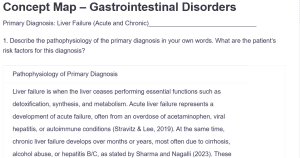Concept Map – Gastrointestinal Disorders
Primary Diagnosis: Liver Failure (Acute and Chronic)_______________________________
- Describe the pathophysiology of the primary diagnosis in your own words. What are the patient’s risk factors for this diagnosis?
| Pathophysiology of Primary Diagnosis | |
| Liver failure is when the liver ceases performing essential functions such as detoxification, synthesis, and metabolism. Acute liver failure represents a development of acute failure, often from an overdose of acetaminophen, viral hepatitis, or autoimmune conditions (Stravitz & Lee, 2019). At the same time, chronic liver failure develops over months or years, most often due to cirrhosis, alcohol abuse, or hepatitis B/C, as stated by Sharma and Nagalli (2023). These systemic effects are manifested when the liver’s function declines and, as a result, its ability to regenerate itself diminishes. | |
| Causes | Risk Factors (genetic/ethnic/physical) |
| Acute liver failure is usually caused by drug toxicity or viral infections, while chronic failure is linked to prolonged liver damage from cirrhosis or hepatitis. | Major risk factors include genetic predisposition, alcohol use, obesity, and chronic exposure to liver toxins or viruses. |
- What are the patient’s signs and symptoms for this diagnosis? How does the diagnosis impact other body systems and what are the possible complications?
| Signs and Symptoms – Common presentation | How does the diagnosis impact each body system? Complications? |
| The manifestations of liver failure are multitudinous. Common manifestations for both acute and chronic include yellowing of skin and eyes (jaundice), general tiredness, ascites (abdominal swelling), and cognitive disturbances, such as confusion or forgetfulness from hepatic encephalopathy. According to Stravitz and Lee (2019), acute liver failure patients may rapidly develop confusion and coma, and patients with chronic liver failure may gradually develop a decline in mental function. Coagulopathy from liver failure also presents with bleeding tendencies because of an inability to produce vital clotting factors. | Impact on Other Body Systems:
Liver failure significantly affects multiple organ systems. The brain is impacted by hepatic encephalopathy, causing cognitive impairment. The kidneys may develop hepatorenal syndrome, leading to kidney failure. The coagulation system is impaired, resulting in an increased risk of bleeding and bruising, and the respiratory system can be compromised through the development of hepatopulmonary syndrome, causing shortness of breath. Complications: Complications include multi-organ failure, sepsis, and eventual death if liver transplantation is not performed in cases of severe acute or chronic failure, as indicated by Batra et al. (2024). |
- What are other potential diagnosis that present in a similar way to this diagnosis (differentials)?
| Hepatic steatosis (fatty liver disease), autoimmune hepatitis, alcoholic liver disease, and Wilson’s disease—which is characterized by copper accumulation in the liver—are among the conditions that can be differentially diagnosed based on similar symptoms. |
- What diagnostic tests or labs would you order to rule out the differentials for this patient or confirm the primary diagnosis?
| Multiple diagnostic tests help confirm whether liver failure exists and rule out other possible conditions. Liver function studies are conducted in the form of measurements of ALT, AST, bilirubin, and alkaline phosphatase levels, as noted by Lala et al. (2020). Coagulation profiles include prothrombin time, expressed as PT/INR, which usually assesses clotting function. Serum ammonia levels help in the determination of hepatic encephalopathy. Imaging studies, including abdominal ultrasound or CT scan, can estimate liver morphology, whereas the diagnosis of underlying disorders like cirrhosis or chronic hepatitis usually requires liver biopsy. |
- What treatment options would you consider? Include possible referrals and medications.
| Liver failure treatment is varied and depends on the etiology. N-acetylcysteine is administered in patients with liver failure due to acetaminophen toxicity (Ershad et al., 2019). Antiviral therapy can be considered in cases of acute HBV or HCV infections. The majority of patients with chronic liver failure are treated with diuretics to manage ascites and lactulose or rifaximin to reduce ammonia accumulation and hepatic encephalopathy. Referral to a hepatologist should be considered for those requiring consideration of liver transplantation, particularly in an acute presentation. Nutritional counseling by a dietician and follow-up care with the gastroenterologist is also important for the chronic sequelae of liver failure. |
References
Batra, N., Gaidhane, S. A., Kumar, S., & Acharya, S. (2024). Outcome predictors of acute-on-chronic liver failure: A narrative review. Cureus, 23(3). https://doi.org/10.7759/cureus.61655
Ershad, M., Naji, A., & Vearrier, D. (2019, March 19). N acetylcysteine. Nih.gov; StatPearls Publishing. https://www.ncbi.nlm.nih.gov/books/NBK537183/
Lala, V., Goyal, A., Bansal, P., & Minter, D. A. (2020). Liver function tests. PubMed; StatPearls Publishing. https://pubmed.ncbi.nlm.nih.gov/29494096/
Sharma, A., & Nagalli, S. (2023, July 3). Chronic liver disease. PubMed; StatPearls Publishing. https://www.ncbi.nlm.nih.gov/books/NBK554597/
Stravitz, R. T., & Lee, W. M. (2019). Acute liver failure. The Lancet, 394(10201), 869–881. https://doi.org/10.1016/s0140-6736(19)31894-x
ORDER A PLAGIARISM-FREE PAPER HERE
We’ll write everything from scratch
Question 
In this exercise, you will complete a Mind Map Template to gauge your understanding of this week’s content. Select one of the possible topics provided to complete your MindMap Template.
Concept Map Template
Primary Diagnosis: ___________________________________________________________
- Describe the pathophysiology of the primary diagnosis in your own words. What are the patient’s risk factors for this diagnosis?
| Pathophysiology of Primary Diagnosis | |
| Causes | Risk Factors (genetic/ethnic/physical) |

Concept Map – Gastrointestinal Disorders
- What are the patient’s signs and symptoms for this diagnosis? How does the diagnosis impact other body systems and what are the possible complications?
| Signs and Symptoms – Common presentation | How does the diagnosis impact each body system? Complications? |
- What are other potential diagnosis that present in a similar way to this diagnosis (differentials)?
- What diagnostic tests or labs would you order to rule out the differentials for this patient or confirm the primary diagnosis?
- What treatment options would you consider? Include possible referrals and medications.
